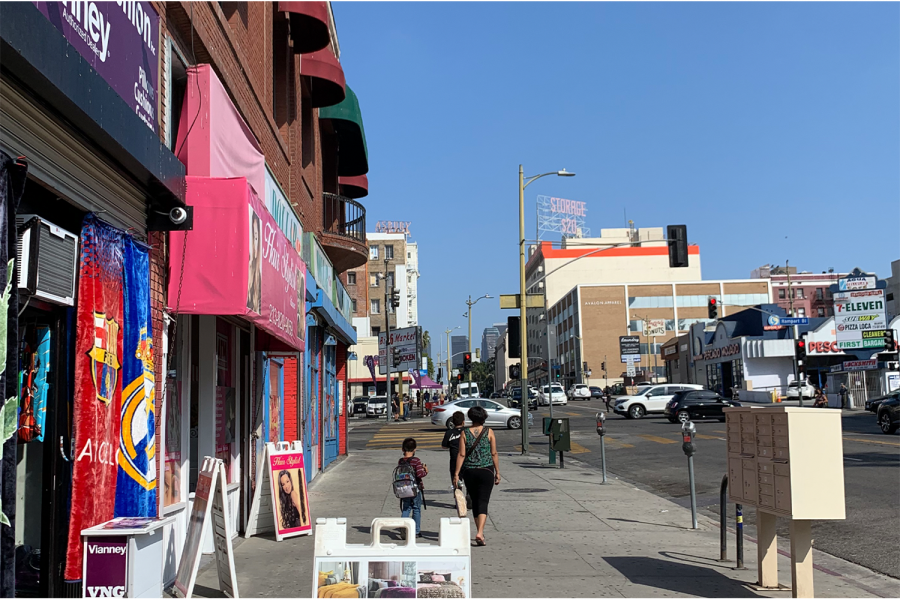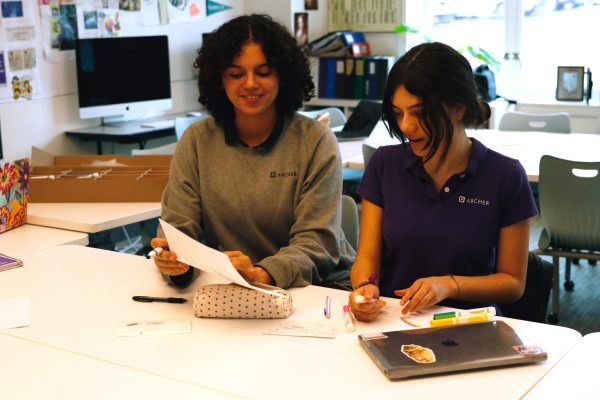‘Striving to help’: Understanding the underlying issues of affordable food
Photo credit: Rose Sarner
A mother and her two children walk away from a Laraya’s Bodega, a local grocery store. The grocery store is located in the middle of downtown Los Angeles and puts an emphasis on healthy nutritious food. According to Feeding America, inn 2020, an estimated 265,000,000 were living with food insecurity, partially due to lack of access to healthful food and affordable groceries.
Imagine your closest supermarket is only a convenience store, barely better than the mart at the corner gas station. The shelves have no fresh fruit or vegetables. In fact, the only produce options in the store are the few cans of corn and beans on the nearly empty shelves. In order to have access to fresh produce, you have to walk four blocks to a bus stop and then walk even further to a grocery store. And then, after all that, you have to do the reverse on your way back with bags full of heavy groceries.
Healthful food and its many benefits are not an everyday reality for many families. According to Harvard’s School for Public Health, this is the reality for many citizens, “7 billion [people in the world] who eat diets low in quality.”
What is a food desert?
A food desert is when residents of a city live in an area without access to fresh produce near their homes and communities.
Data from 2012-2013 study showed that the average distance from U.S. households to the nearest supermarket was 2.19 miles. The U.S. Department of Agriculture estimates that 2.3 million Americans live more than 1 mile away from a grocery store and do not own a car.
According to the article “Access to Foods That Support Healthy Eating Patterns,” easier access to healthy foods leads to healthier dietary practices. Not having healthier options at your disposal can make implementing healthy choices into your life unachievable.
A study in Detroit found that “people living in predominantly Black low-income neighborhoods travel an average of 1.1 miles farther to the closest supermarket than people living in predominantly white low-income neighborhoods.”
The term “food desert” also takes into account the affordability of local grocery stores. Many people do not have access to healthy food because of the expensive commute. Paying for public transportation and gas on top of the price of the food all adds up and becomes too high for many people.
On top of the expense of having to travel to healthy grocery stores, the options are much more limited in low-income and rural areas. According to the USDA, “building a new store does not mean people will shop there; the store has to offer the products, prices and other characteristics that shoppers value.”
Physical distance and the expensive pricing of healthy produce is an impediment to adequate access to food and one of the main issues that prevent many citizens from receiving healthy produce.
According to the article “Access to Foods That Support Healthy Eating Patterns,” there are many factors that determine people’s access to healthy foods, such as education, economic stability, health, health care, neighborhood, built environment and the social and community context. Healthy eating habits, such as controlling calories, eating a variety of foods and beverages from all food groups and limiting intake of saturated and trans fats, added sugars and sodium lower the risk for chronic disease. Poor nutrition and an unhealthy diet, on the other hand, are risk factors for high blood pressure, diabetes and cancer.
Food As Medicine
Food is medicine and the power of nutrition is being explored more and more every day as people study how food people consume affects their everyday lives, in addition to their long-term health. According to Healthline, “eating whole, nutritious foods is important because their unique substances work synergistically to create an effect that can’t be replicated by taking a supplement.”
Many professionals are beginning to acknowledge and advocate for food’s lasting power.
“The idea of food as medicine is not only an idea whose time has come,” Dr. Dariush Mozaffarian said, a cardiologist and the Dean of the Friedman School of Nutrition Science and Policy at Tufts University. “It’s an idea that’s absolutely essential to our health care system.”
Exploring the idea of food is medicine is Olivia Massa. Massa works at Movable Feast, where she creates menus that are medically appropriate to meet the needs of her clients using nutrition strategies and food to help combat individual’s needs and fight diseases.
“Food is what nourishes our body and that can play a role in things like chronic diseases,” Massa said. “Helping people understand that what you’re putting into your body matters is one of my main goals.”
Bringing Nutrition To Those Most In Need
There are many health benefits that marginalized groups are missing out on. The affordability of fresh produce influences people’s access to foods that support healthy eating patterns. Researchers have found that low-income groups tend to rely on foods that are cheap and convenient to access but are low in nutrient density due to factors such as grocery store’s heightened prices.
“Moveable Feast” is a United States company that focuses on combatting this exact problem. Not only do they provide nutritious meals to low-income individuals, they also provide assistance to those with underlying health problems who do not know how to care for themselves or manage their own nutrition.
In addition to nutritious meals, “Moveable Feast” provides medical nutrition therapy to help clients manage their illness, their medications and their medical treatments.
“The whole goal is to help [individuals] have access to healthier foods so that they have less of that burden of trying to get healthful foods to meet their needs, while dealing with their chronic disease. So there’s that nutrition component that’s with it and that’s really where I play a role,” Massa, a registered dietitian for Moveable Feasts, said.
Sydney Streimer is a Fitness and Wellness Teacher at Archer. Streimer started teaching fitness at an all-girls school in New York for five years before moving to Los Angeles, where she continued pursuing her passion for teaching wellness. Streimer has been teaching fitness for seven years now and has witnessed what wellness education looks like across the country.
“I found that giving back and teaching….was something really rewarding,” Streimer said. “And I knew I was making a greater impact on their day, lives and their health [by educating them].”
Streimer noticed gaps within her own health education as a child.
“I didn’t really learn much [about nutrition] from school other than the FDA’s MyPlate and the different food groups. But then as I got older through college, I started to realize how the effects of food made me feel,” Streimer said. I realized that food can have a greater impact than just my body. I can be choosing things to eat to possibly enhance the world that we’re living in.”
Call For Action
Caring for your health is much easier when you have fresh produce at a reasonable price within an easy distance from your house.
Tina Raultz is a registered dietitian at Parsley Health, a doctor-led, holistic medicine practice that focuses on treating the root cause of health issues.
“Prescriptions have their place, they’re very important, but they mainly focus on addressing symptoms. Functional Medicine focuses on the root of the issue and tries to understand it from a perspective of not only the symptoms but addressing the individual instead of treating people simply like statistics,” Raultz said.
Making health sustainable is a multifaceted issue that has many layers. Most individuals fall short of taking care of their health issues because they do not know how to make a life switch and sustain their progress.
“If you teach a person to fish, they’ll sustain it for a long time,” Raultz said. “[Functional medicine] is of that same mentality — it is not a one-size-fits-all approach. Sometimes you need to tailor the idea of health to fit the individual to make it realistic; not everything is going to work for everybody.”
Our Own Nutritional Desert
“It’s one thing to provide people with food and it’s another to teach food literacy. One of the biggest challenges with foods that we consider healthy and more nutrient dense is that sometimes they need some more flavor,” Raultz said. “They’re not as exciting as a bag of Cheetos, but they can be.”
According to Streimer, nutritional education is not a priority in the United States education system. Typically, wellness programs focus more on physical education rather than what is put inside our bodies, which have the more long term effects.
Although nutrition education is a part of the Archer Fitness and Wellness curriculum, due to the pandemic, Amelia Mathis, the Fitness and Wellness department chair said that Archer has restructured the curriculum to instead meet the students needs.
“We have been using a Wellness Wheel as a resource to keep students balanced, and nutrition is a part of that,” Mathis said. “In the past, we have looked at nutrition in a deeper way but this year we have simplified and really honed in on the connection. But we do not have a nutrition class it is integrated within our curriculum mindfully.”
Striemer hopes to explore nutrition next year on a deeper level.
My biggest focus this year was mental health, and with mental health comes, ‘How do you fuel your body, how do you fuel your mind?’ [Nutrition] would be an avenue that I would love to explore and maybe gather some more professional development before getting deep into the subject of nutrition,” Streimer said. “I did teach nutrition last year, and the main focus was what can you include daily to make you feel good, and when you are eating, how can you be mindful?”
According to experts like Raultz, small incremental changes are what will influence the world and move the health industry forward.
“Usually it takes some discomfort, it takes some not so great health symptoms,” Raultz said. “But if it leads to better, long-lasting changes in the long run, then it can be worth it.”

Rose Sarner joined the Oracle as a staff reporter in 2020 and was the Culture Editor starting in 2021 until she graduated in 2023. Sarner graduated in...










Tiffany Smith-Anoa'i • May 23, 2021 at 8:33 pm
Great reporting Rose! This is a very important topic and you laid out the issues as well as possible solutions in a clear fashion. We can all do our part!
Brava!